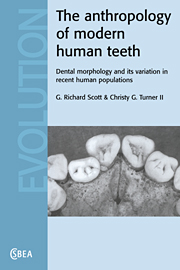 The Anthropology of Modern Human Teeth
The Anthropology of Modern Human Teeth Book contents
- Frontmatter
- Dedication
- Contents
- Acknowledgments
- Prologue
- 1 Dental anthropology and morphology
- 2 Description and classification of permanent crown and root traits
- 3 Biological considerations: ontogeny, asymmetry, sex dimorphism, and intertrait association
- 4 Genetics of morphological trait expression
- 5 Geographic variation in tooth crown and root morphology
- 6 Establishing method and theory for using tooth morphology in reconstructions of late Pleistocene and Holocene human population history
- 7 Tooth morphology and population history
- Epilogue
- Appendixes
- References
- Index
5 - Geographic variation in tooth crown and root morphology
Published online by Cambridge University Press: 05 September 2015
- Frontmatter
- Dedication
- Contents
- Acknowledgments
- Prologue
- 1 Dental anthropology and morphology
- 2 Description and classification of permanent crown and root traits
- 3 Biological considerations: ontogeny, asymmetry, sex dimorphism, and intertrait association
- 4 Genetics of morphological trait expression
- 5 Geographic variation in tooth crown and root morphology
- 6 Establishing method and theory for using tooth morphology in reconstructions of late Pleistocene and Holocene human population history
- 7 Tooth morphology and population history
- Epilogue
- Appendixes
- References
- Index
Summary
Introduction
Early in the twentieth century, world-renowned paleontologist William King Gregory (1922) expressed the view that tooth crown morphology varied hardly at all among the major races of humankind. Traits he noted as exceptions to this ‘generalization’ included shovel-shaped incisors, distinguishing Asians from non-Asians, Carabelli's cusp, distinguishing Europeans from non-Europeans, and molar cusp numbers and patterns, for which Europeans showed more cusp reduction (i.e., hypocone and hypoconulid loss) and groove pattern simplification (i.e., from Y to +) than Asians and Africans.
In 1922, when Gregory published his treatise The Origin and Evolution of the Human Dentition,his belief about limited human dental variation was fundamentally correct as far as was then known. Few crown traits had been defined, root variants were largely unknown, and, as Sir Arthur Keith (1931) noted, much of the world remained in a state of ‘dental darkness.’ Prior to 1920, Europeans were the primary focus of dental researchers while groups representing other major geographic races had barely been examined, if at all.
Campbell's (1925) monograph on the dentition of Australian Aborigines was a major cornerstone for subsequent characterizations of non-European dental morphological variation as well as other dental anthropology topics. Shaw (1931), stimulated by Campbell's effort, observed crown and root traits in the Bantu dentition, along with dental pathologies and jaw characteristics. Hrdlicka (1920) had earlier described shovel-shaped incisors in Native Americans, followed by multiple morphological characterizations of this group by Nelson (1938), Goldstein (1948), Dahlberg (1951, 1963a), and others, including P.O. Pedersen (1949) and C.F.A. Moorrees (1957) who wrote invaluable monographs on the dentitions of linguistically related East Greenland Eskimos and Aleuts, respectively.
Despite an upsurge in interest in dental morphological variation during the middle of the twentieth century, it was still not possible, even as late as 1970, to characterize more than a few crown traits on a worldwide scale. Shovel-shaped incisors, Carabelli's trait, and lower molar cusp number and pattern were exceptional in this regard, but some major geographic areas were still poorly known even for these widely studied traits, especially Africa, India, and Central and far Northeast Asia.
- Type
- Chapter
- Information
- The Anthropology of Modern Human TeethDental Morphology and its Variation in Recent Human Populations, pp. 165 - 242Publisher: Cambridge University PressPrint publication year: 1997
- 3
- Cited by


